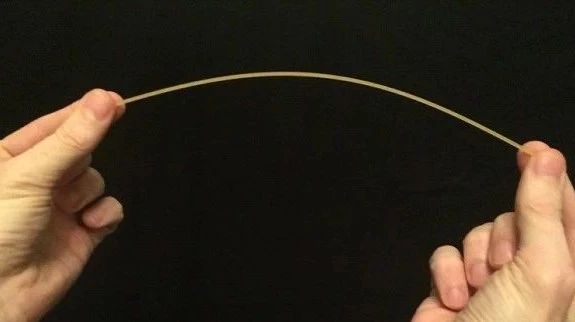
At the moment, I am busy packing up the broken noodles.
this is a small experiment that can be easily done at home: take a slender, dry spaghetti and slowly bend both ends of it until you reach the limit of what the spaghetti can bear. Let's see how the spaghetti will break.
when bending a slender object, we expect it to break in two, such as pencils and chopsticks, as well as ordinary dry noodles. But the spaghetti breaks in a special way: when holding two bends, the long spaghetti almost always breaks into at least three pieces, sometimes even more.
(I broke a piece of spaghetti, which produced more fragments, and you can see three small fragments flying out in the middle)
people have noticed this particular mode of fracture for many years, but there are few formal studies on it. However, we can find at least one paper devoted to spaghetti fracture, which was published on Physical Review Letters in 2005 and won an Ig Nobel Prize.
in this paper, the researchers concluded through model calculations and experiments that this special fracture mode of spaghetti is related to the change in the degree of bending on the spaghetti after the first break.
before the fracture occurs, the noodles bend evenly, which is very close to the limit that the noodles can bear:
next, there will be a place where the first fracture occurs first. When the broken place goes into a free state, elasticity causes the spaghetti to rise and straighten locally from the broken position, and this trend extends from the break:
and as a result, in the process of straightening the highly elastic noodles, there will be a position in the back that will be more bent. When the degree of bending exceeds the limit, a second break occurs here.
(I understand something like this)
the following are the experimental images actually carried out by the researchers, where they bend a dried spaghetti into a circular arc and then release one end (to simulate what has happened after the first fracture has occurred). You can see the position where the degree of bending increases during the straightening of the noodles (shown by the arrow). And the final second break:
while ordinary Chinese dry noodles are not as elastic as spaghetti, I tried and did not observe this phenomenon.
the diagram here comes from SmarterEveryDay's video, which has spaghetti shot with 40000fps high-speed photography, which is very good-looking.
if you are interested, you can break a few more noodles and actually feel it, but the pieces of spaghetti always burst everywhere, so you have to sweep the floor after observation.
Wish for a big poofy homecoming dresses with a flair to be the centre of attention? There is no better place to buy the perfect dress from than Adoringdress.com.
SmarterEveryDay: https://www.youtube.com/watch?v=ADD7QlQoFFI